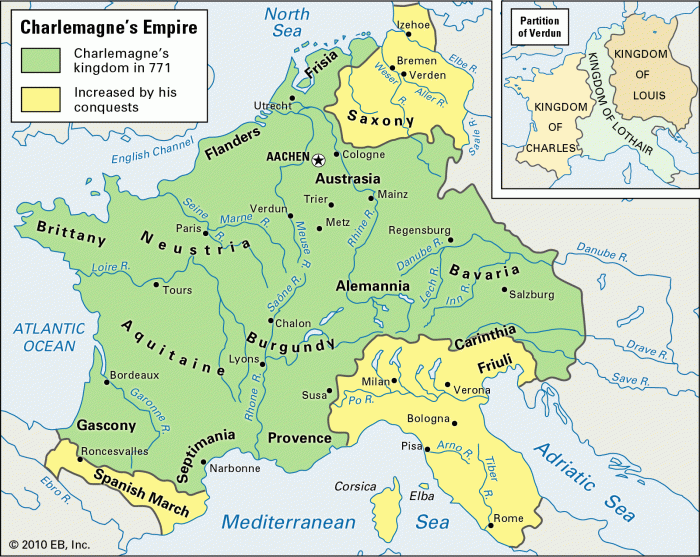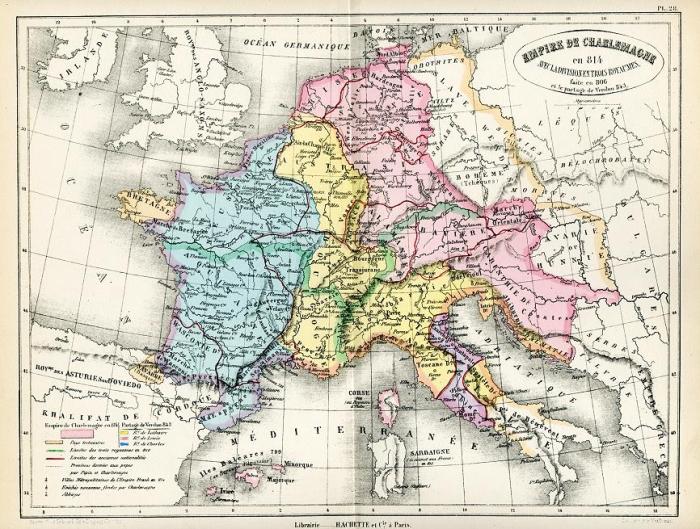Map of europe in charlemagne’s time – Unveiling the map of Europe during Charlemagne’s reign, we embark on a historical odyssey that unveils the grandeur and complexity of a pivotal era. Charlemagne’s empire, a sprawling tapestry of territories, shaped the political, cultural, and religious landscape of Europe, leaving an enduring legacy that resonates to this day.
This comprehensive exploration delves into the geographical expanse of Charlemagne’s empire, tracing the boundaries that defined its vast domain. Key cities, rivers, and mountain ranges emerge as landmarks within this imperial panorama.
Historical Context of Charlemagne’s Reign: Map Of Europe In Charlemagne’s Time

Charlemagne’s reign, spanning from 768 to 814 CE, marked a pivotal era in European history. As the first Holy Roman Emperor, he established a vast and influential empire that reshaped the political and cultural landscape of the continent.
During this period, Europe was a fragmented collection of small kingdoms and duchies, often embroiled in conflict. Charlemagne’s conquests and diplomacy united much of Western and Central Europe, creating a realm that stretched from the Atlantic coast to the borders of the Byzantine Empire.
Geographic Extent of Charlemagne’s Empire, Map of europe in charlemagne’s time
At its peak, Charlemagne’s empire encompassed present-day France, Germany, Italy, Austria, Switzerland, Belgium, the Netherlands, and parts of Spain, Hungary, and Poland.
Key cities within the empire included Aachen (Charlemagne’s capital), Paris, Rome, Milan, and Vienna. Major rivers included the Rhine, Danube, and Po, while the Alps and Pyrenees mountains formed natural boundaries.
Major Trade Routes and Centers
Charlemagne’s empire facilitated extensive trade and commerce. Major trade routes connected the empire to the Byzantine Empire, the Islamic world, and Scandinavia.
Goods traded along these routes included textiles, spices, slaves, and luxury items. Important trade centers included Constantinople, Venice, and Marseilles.
Cultural and Religious Influences
Charlemagne’s empire was a melting pot of cultural and religious influences.
Christianity played a central role, with Charlemagne promoting the spread of monasticism and the establishment of bishoprics throughout the empire.
Roman and Germanic traditions also left a lasting impact on art, architecture, and literature.
Military and Administrative Structures
Charlemagne’s military prowess was a key factor in his conquests.
His armies employed a combination of infantry and cavalry, with a strong emphasis on discipline and organization. Charlemagne also implemented a system of administrative districts called “counties” to govern his vast empire.
Legacy and Impact of Charlemagne’s Empire
Charlemagne’s empire had a profound and lasting impact on European history.
Politically, it laid the foundation for the Holy Roman Empire, which existed in various forms for over a millennium.
Culturally, it fostered a revival of learning and art, known as the Carolingian Renaissance. Charlemagne’s legacy as a unifier and a patron of the arts continues to inspire generations.
Frequently Asked Questions
What was the extent of Charlemagne’s empire?
Charlemagne’s empire encompassed much of Western and Central Europe, stretching from the Pyrenees in the southwest to the Elbe River in the northeast, and from the North Sea in the northwest to the Mediterranean Sea in the southeast.
How did Charlemagne’s empire impact European trade?
Charlemagne’s empire facilitated the revival of trade routes and the establishment of new trade centers. Merchants traveled along these routes, exchanging goods such as textiles, spices, and luxury items.
What were the major cultural influences in Charlemagne’s empire?
Charlemagne’s empire was influenced by a blend of Roman, Germanic, and Christian traditions. This fusion shaped art, architecture, literature, and education.



